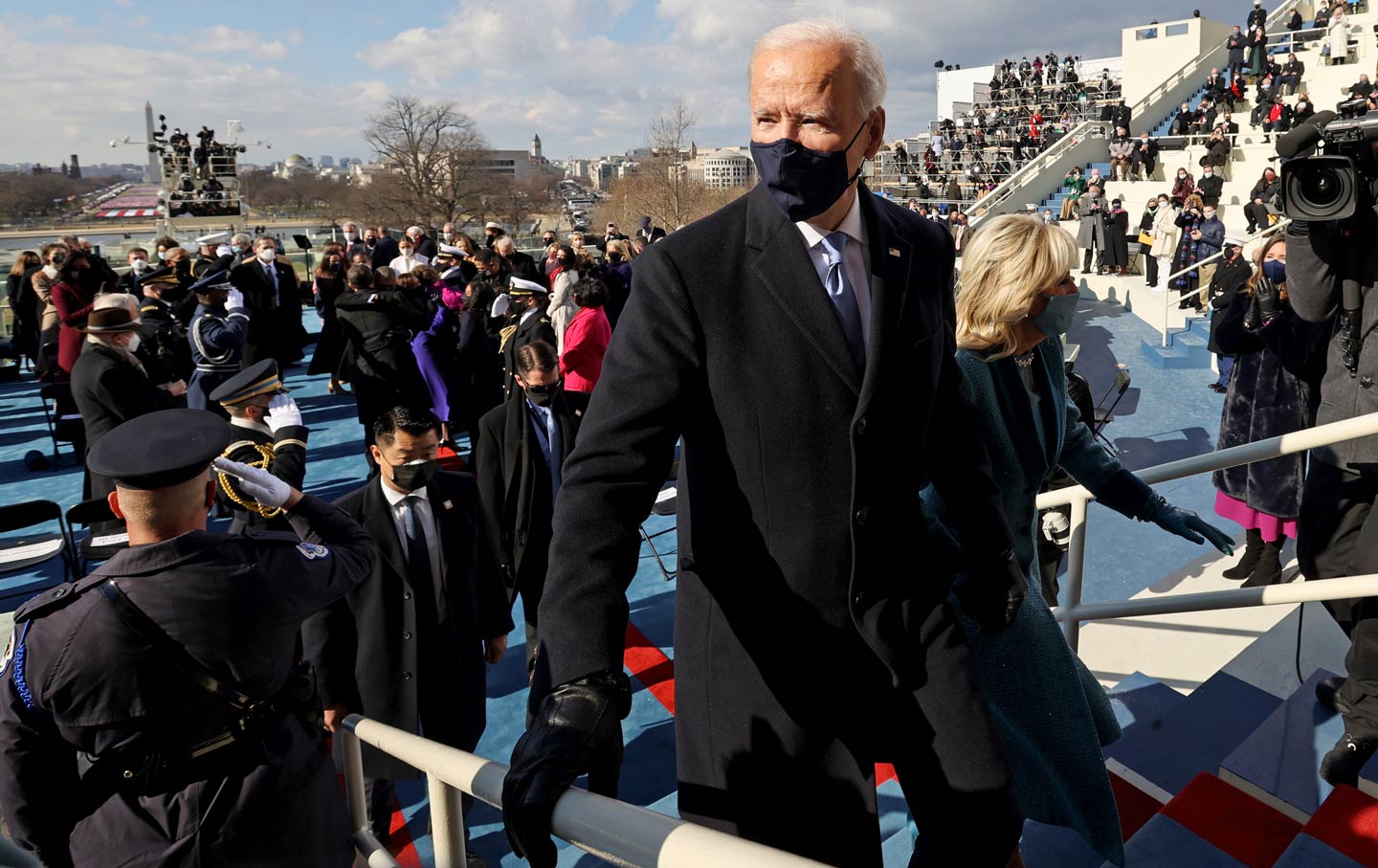
President Joe Biden on the day of his inauguration.(Jonathan Ernst / AFP via Getty Images)
Washington, D.C.—On the final morning of the Trump presidency, the city was quiet.
By 8:30 am, a crowd had gathered outside the Cathedral of St. Matthew the Apostle, where Joe Biden was scheduled to attend mass. A glut of police vehicles blocked the entrance, dashing hopes of glimpsing the soon-to-be president, but a sense of expectation was palpable—a desire to be part of something on this momentous day. One woman wore a Biden–Harris mask made entirely of sequins. Another woman’s mask read simply, “The Future.” An older gentleman said quietly, to himself, “It really is remarkable.”
On any other Inauguration Day—especially one welcoming a Democratic administration—D.C. residents would pour from their homes to join the festivities, like on the first day of spring at the end of a long winter. But this year a deadly riot at the Capitol and an out-of-control pandemic had combined to make public celebration impossible. Amid threats of further violence from the far right, the district and the Presidential Inaugural Committee had urged people to celebrate at home and participate in the swearing-in ceremony virtually. So the capital city was a ghost town; save for joggers, dog walkers, and the occasional Biden supporter, Washington’s wide boulevards sat empty.
What there was, in abundance, were security personnel: police, Secret Service, Homeland Security, TSA, and more. A National Guard contingent of some 15,000 soldiers, mobilized in the wake of the January 6 Capitol attack, had swelled in recent days to more than 25,000. Armed with M4s and pistols, Guardsmen were everywhere downtown. They stood in packs at barricades, in the middle of the road, and outside of an open Starbucks. Some soldiers stood adjacent to homeless encampments—truly a picture of America, at a time when millions have lost jobs and housing because of the coronavirus pandemic.
Heavy fences and security checkpoints dominated the usually bustling streets. In the end, no violence materialized, and the few Trump supporters I spotted were subdued. Dressed in MAGA gear and still waving Trump 2020 flags, they looked lost.
At Black Lives Matter Plaza, in view of the White House and with an hour to go until Biden’s swearing in, the crowd was small but lively. A loudspeaker played Marvin Gaye, Simon & Garfunkel, and Elvis Presley. A woman in a Black Lives Matter T-shirt flew a small kite emblazoned with the words madam vp. Her mask, black with pink letters, read the same. Through steel barricades, past a handful of soldiers and cops, you could still see the hundreds of homemade signs on the fence erected around the White House during the summer’s historic racial justice protests. bye don, one read. Earlier in the morning, when Marine One took off from the White House lawn carrying Trump—he was en route to Andrews Air Force Base and then Florida—people in the plaza had danced.
With most people staying home, journalists outnumbered civilians in comic proportion. I listened to one woman, who had traveled from Boise, Idaho, for the inauguration, give interviews to reporters from at least Japan, France, and Romania. (“Joe Biden is going to unify our country,” she told them all.) Compelling imagery was in short supply for photographers, so even the smallest fascination—a woman burning sage and blowing bubbles, say—attracted a dozen or more professional-grade cameras to capture the moment. In the small group of journalists that I buddied up with, we took pictures of journalists taking pictures. One, Jack Crosbie, a writer for Discourse Blog, remarked that he couldn’t believe he’d packed body armor for this.
At the intersection of F Street and 14th Street Northwest, reporters with cameras and microphones formed a wide half-circle around a young woman in a MAGA hat who held forth that the Capitol attack was an inside job instigated by antifa. Even with Trump gone, the press couldn’t help but lavish attention on demonstrably false nonsense.
A block from that spot, on 13th Street and just before noon, several hundred people waited to be screened for entrance onto Pennsylvania Avenue, where later they would cheer the new president’s motorcade. More than a mile away, the inauguration ceremony was underway; people in line turned to their phones. Through so many tiny speakers, their audio streams all slightly out of sync with the others, we heard Kamala Harris become vice president and then Joe Biden the 46th president of the United States. “It’s over!” someone cheered. “It’s over!”
“That was awesome,” said a tall man in a gray sweater. “And we were here to see it.”
“Kind of,” he added, glancing at the buildings on both sides of the street.
And that’s how the Biden presidency began for the people of D.C.: Most were at home. Some were in the streets, out of view of the Capitol. Almost no one could participate in person—in a way, one final thing taken by Trump’s tenure as president.
But there was also something gained, in a collective sigh of relief. Those who have lived in D.C. know that the person in the White House can have a profound impact on the mood of the city. For the people I know, that’s meant not just the grief that so many Americans have felt, that knot in our souls that wouldn’t be undone, but the sickening knowledge that we shared air with an avowedly racist and determinedly cruel president and the noxious likes of Stephen Miller, Jared & Ivanka, William Barr, Betsy DeVos, Mike Pompeo, and all the rest. Biden and Harris have their work cut out for them. But on Wednesday that knot loosened slightly, and the city, suddenly, felt cleaner.
Andrew McCormickTwitterAndrew McCormick is an independent journalist in Washington, D.C. His work has appeared in The New York Times, The Atlantic, Columbia Journalism Review, and the South China Morning Post, among other publications. He is a US Navy veteran.